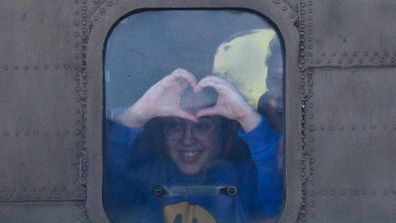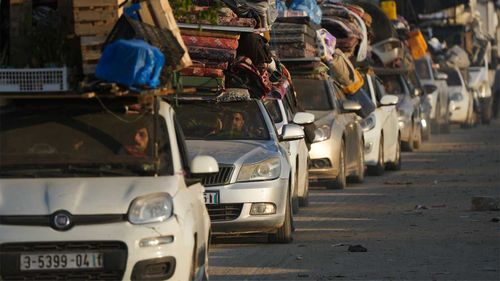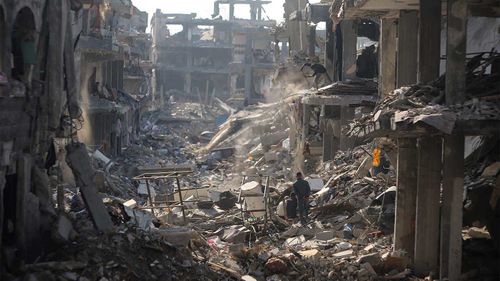Hamas-led militants have freed the first of eight hostages in the latest release since a ceasefire in the Gaza Strip took hold earlier this month. Israel was expected to release another 110 Palestinian prisoners.
The truce is aimed at winding down the deadliest and most destructive war ever fought between Israel and Hamas, whose October 7, 2023, attack into Israel sparked the fighting. It has held despite a dispute earlier this week over the sequence in which the hostages were released.
Hamas on Thursday handed female Israeli soldier Agam Berger, 20, to the Red Cross after parading her in front of a crowd in the heavily destroyed urban refugee camp of Jabaliya in northern Gaza. The Israeli government later confirmed that Berger was with its forces.

People cheered, clapped and whistled at a square in Tel Aviv where supporters of the hostages watched Berger’s handover on big screens next to a large clock that’s counted the days the hostages have been in captivity.
Some held signs saying: “Agam we’re waiting for you at home.”
Another handover point was prepared in the southern Gaza city of Khan Younis, in front of the destroyed home of slain Hamas leader Yahya Sinwar.
Hundreds of militants from Hamas and the smaller Islamic Jihad group arrived with a convoy in a show of force, and thousands of people gathered to watch, some from the tilted rooftops of bombed-out buildings.
The other two Israelis set to be released Thursday are Arbel Yehoud, 29, and Gadi Moses, an 80-year-old man. Five Thai nationals are also expected to be freed, but have not been officially identified.
A number of foreign workers were taken captive along with dozens of Israeli civilians and soldiers during Hamas’ October 7, 2023 attack that set off the war. Twenty-three Thais were among more than 100 hostages released during a weeklong ceasefire in November 2023. Israel says eight remain.

Of the people set to be released from prisons in Israel, 30 are serving life sentences after being convicted of deadly attacks against Israelis. Zakaria Zubeidi, a prominent former militant leader and theatre director who took part in a dramatic jailbreak in 2021 before being rearrested days later, is also among those set to be released.
Israel said Yehoud was supposed to have been freed on Saturday and delayed the opening of crossings to northern Gaza when she was not.
The United States, Egypt and Qatar, which brokered the ceasefire after a year of tough negotiations, resolved the dispute with an agreement that Yehoud and two other hostages would be released on Thursday. Another three hostages, all men, are set to be freed Saturday along with dozens more Palestinian prisoners.
On Monday, Israel began allowing Palestinians to return to northern Gaza, the most heavily destroyed part of the territory, and hundreds of thousands streamed back. Many found only mounds of rubble where their homes had been.

Israeli hostages’ triumphant return as ceasefire enters seventh day
Ceasefire holds for now but next phase will be harder
In the first phase of the ceasefire, Hamas is set to release a total of 33 hostages, including women, children, older adults and sick or wounded men, in exchange for nearly 2000 Palestinian prisoners. Israel says Hamas has confirmed that eight of the hostages to be released in this phase are dead.
Palestinians have cheered the release of the prisoners, who are widely seen by Palestinians as heroes who have sacrificed for the cause of ending Israel’s decades-long occupation of lands they want for a future state.
Israeli forces have meanwhile pulled back from most of Gaza, allowing hundreds of thousands of people to return to what remains of their homes and humanitarian groups to surge assistance.

The deal calls for Israel and Hamas to negotiate a second phase in which Hamas would release the remaining hostages and the ceasefire would continue indefinitely. The war could resume in early March if an agreement is not reached.
Israel says it is still committed to destroying Hamas, even after the militant group reasserted its rule over Gaza within hours of the truce. A key far-right partner in Prime Minister Benjamin Netanyahu’s coalition is already calling for the war to resume after the ceasefire’s first phase.
Hamas says it won’t release the remaining hostages without an end to the war and a full Israeli withdrawal from Gaza.
The United States has provided crucial military and diplomatic support to Israel throughout the war and is seen as key to ending the conflict. U.S. President Donald Trump has been a staunch supporter of Israel but has also pledged to end the wars in the Middle East.
Trump’s Mideast envoy, Steve Witkoff, was in Israel on Wednesday and met with Prime Minister Benjamin Netanyahu, who heads to Washington next week as the first foreign leader to meet Trump in his second term.

Hamas started the war when it sent thousands of fighters storming into Israel on October 7, 2023. The militants killed some 1200 people, mostly civilians, and abducted around 250.
Israel’s air and ground war was among the deadliest and most destructive in decades. More than 47,000 Palestinians have been killed, over half of them women and children, according to Gaza’s Health Ministry, which does not say how many of the dead were militants.
The Israeli military says it killed over 17,000 fighters, without providing evidence, and that it went to great lengths to try to spare civilians. It blames civilian deaths on Hamas because its fighters operate in dense residential neighborhoods and put military infrastructure near homes, schools and mosques.
The Israeli offensive has transformed entire neighborhoods into mounds of gray rubble, and it’s unclear how or when anything will be rebuilt. Around 90 per cent of Gaza’s population has been displaced, often multiple times, with hundreds of thousands of people living in squalid tent camps or shuttered schools.








